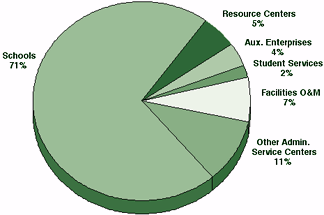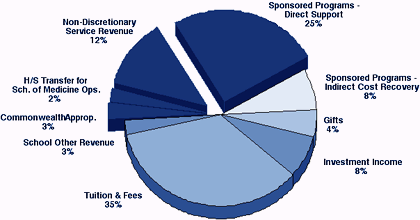 |
|
Budget 1999-2000: President Rodin's
and Provost Barchi's Reports to the University Council
President Rodin's report to Council includes the University's goals
and academic priorities, as well as the initiatives that will be implemented
in the FY2001 budget; they are shown below. The pie charts show how the
funds are spent.
At right the Consolidated Budget pie chart shows the Academic Expense
is 44% of the total with the remainder spent by the Health Services.
Below right, the pies show that compensation
remains at 54% as it was last year; the schools spend 71% of the Academic
Budget and the breakdown by school reflects their relative size.
Further below, the tables show the indirect
cost recovery rates the Provost spoke about as well as the tuition and endowment
compared to peer institutions. |
FY 2000 Consolidated Expenditure Budget
Total=$3.048 Billion

Components of the Consolidated University Budget
The Consolidated University budget has two major components -- "Academic"
and "Health Services."
The Academic budget includes:
- Schools (including the School of Medicine)
- Resource Centers
- Auxiliaries
- Central Service Centers
The Health Services budget includes all components of UPHS except
for the School of Medicine:
- Hospital of the University of Pennsylvania (HUP)
- Presbyterian Medical Center (PMC)
- Pennsylvania Hospital
- Phoenixville Hospital
- Clinical Practices of the University of Pennsylvania (CPUP)
- Clinical Care Associates (CCA)
[For UPHS Constraints, CLICK
HERE] |
|
- Attain comprehensive excellence and secure Penn's position as one of
world's premier research and teaching universities.
- Secure greater research funding and new sources of support.
- Restructure, improve and cut costs of administration.
- Invest in strategic master's and continuing education programs that
can generate revenue.
- Enhance government and community relations programs essential to Penn's
best interests.
- Increase Penn's international reach and global perspective.
- Creatively deploy new technologies.
- Effectively communicate Penn's contributions to the media and the University's
various constituencies.
- Raise the funds required to support Penn's strategic goals.
|
FY 2000 Academic Budget Expenditures by
Expense Type
Total = $1.329 Billion

- Life Sciences, Technology & Policy
- American & Comparative Democratic & Legal Institutions
- Management, Leadership & Organizations
- The Humanities--Meaning in the 21st Century
- The Urban Agenda--Penn in Philadelphia
- Information Science, Technology & Society
|
|
How the University's Budget Supports the Goals and Priorities of the
Agenda for Excellence
- Provost and Deans work together to develop School budgets that maximize
level of resources available for investment in strategic goals and priorities.
- Executive Vice President and Vice Presidents work together to develop
Central Service Center budgets that maximize level of resources available
for investment in strategic goals and priorities.
- Limited central resources--e.g., Subvention, Research Facilities funding,
Facilities
- Renewal Program funding--are directed wherever possible towards investments
in the Schools that support their most important goals and priorities and
the Agenda
for Excellence.
|
FY 2000 Academic Budget Expenditures by
Responsibility Center Category
Total = $1.329 Billion

Penn's Financial Planning Approach
- The University engages in strategic long-term financial planning.
- New programs, priorities and initiatives are discussed and planned
long before they are included in the annual University operating budget.
- Consultation occurs through the Academic Planning & Budget Committee
and in other forums.
- New initiatives that will be implemented and budgeted in Penn's Fiscal
Year 2001 budget have been identified and publicized already-during the
current year or prior years.
|
|
Examples of Strategic Initiatives in Penn's FY 2001 Budget
- Computer and Information Science: New faculty and facilities--Levine
Hall
- Management, Leadership & Organizations: Huntsman Hall--New facilities
to support new approaches to management education
- Genomics and Life Sciences: New facilities and academic programs
- Undergraduate Fine Arts: New home in Addams Hall
- Renovation of Graduate Education building
- Completion of Law and Dental building projects
- Next installment of classroom renovation projects
- Undergraduate and graduate financial aid increases
- Funding for minority recruitment and retention projects
|
FY 2000 Academic Budget Expenditures by
School
Total = $944 Million

- Student Life:
- College Houses, Quad Renovation/Expanded Living Learning Programming
- Opening of Perelman Quad and Wynn Common
- Locust Walk-Christian Association, Veranda, 3619
- Development of Pottruck Health and Fitness Center
- Quality of Life/Neighborhood Initiatives: Hamilton Square; Westside
Common; West Philadelphia programs
|
|
FY 2000 Academic Budget Total Revenue by
Source
Total = $1.329 Billion

|
Rate of Tuition & Fee Growth: A 20-Year
History

For information concerning Recent History of Undergraduate Charge
Increases, the Tuition, Fee, Room and Board Increases, and Peer Institution
Undergraduate Charges Comparison, see Almanac March 28, online at
www.upenn.edu/almanac/v46/n26/032800.html. |
Peer Institution Endowment/Student Among
Top 20 Endowments as of June 30, 1999
| Institution |
Assets ($000) |
($/Student) |
| Princeton University |
6,469,200 |
1,007,978 |
| Harvard University |
14,255,996 |
795,092 |
| Yale University |
7,197,900 |
661,572 |
| Stanford University |
6,005,211 |
456,774 |
| M.I.T. |
4,287,701 |
441,031 |
| Washington University |
3,761,686 |
365,425 |
| Dartmouth College |
1,710,585 |
327,950 |
| Chicago, University of |
2,762,686 |
246,845 |
| Columbia University |
3,636,621 |
186,666 |
| Northwestern University |
2,634,850 |
174,702 |
| PENN |
3,281,342 |
166,262 |
| Cornell University |
2,869,103 |
151,548 |
Illustrative Life Sciences Commitments by Peer Institutions
|
|
$500 Million |
Natural Sciences expansion-Molecular Biology and Neuroscience buildings |
|
|
$350 Million |
McGovern Institute for Brain Research |
|
|
$200 Million |
Strategic research areas in life sciences |
|
|
$150 Million |
Bio-X building |
|
|
$100 Million |
Genomics initiatives and buildings |
|
Sponsored Project Activity by Fiscal Year
Total Awards Received ($000)

|
Housing and Dining Renewal Program Funding
- Estimated total project cost of residential and dining initiative is
$378.5 million (in FY 2000 dollars)
- Project cost will be covered in part by $56 million in gifts, leaving
$322.5 million to be funded through debt
- Annual debt service funding shortfall could range from $4 million to
$20 million
|
Total Indirect Cost Recovery by Fiscal
Year
($000)

|
New Constraints Connected to Health System
- Health System cannot provide the same level of support for University
activities
- Financial pressure on School of Medicine will limit its ability to
contribute to University finances
- University remains committed to academic excellence in School of Medicine
|
Federal Indirect Cost Recovery Rate by
Fiscal Year

|
How Penn is Achieving its Goals in Light of Serious Fiscal Constraints
- Development: Ambitious, successful, focused fundraising in support
of goals and priorities of the Agenda
for Excellence
- Efficiency: Reduce central administrative expenditures and work with
the Schools to constrain school-level administrative expenses. Reduce operating
deficits in Penn "Resource Centers." Enhance strategies for Health
System cash flow and cash recapture.
- University/Private Sector Partnerships: Getting others to spend their
money to do things Penn needs so that our own resources can be spent on
core academic priorities.
|
More on Budget: The University's fiscal year begins July 1.
The budget for FY 2001 will be reviewed and approved by the Trustees at
their June 16 Stated Meeting.
Almanac, Vol. 46, No. 32, May 9, 2000
| FRONT
PAGE | CONTENTS
| JOB-OPS
| CRIMESTATS
| COUNCIL
COVERAGE: Budget Presentations 1999-2000 | BENCHMARKS:
Penn-West Phila. Schools Partnerships | TALK
ABOUT TEACHING ARCHIVE | BETWEEN
ISSUES | MAY at PENN |
|
|
|









